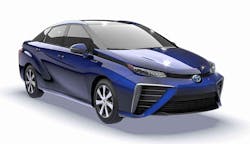Japan Aims to Eliminate Gas-Powered Vehicles by Mid-2030s
>> Electronic Design Resources
.. >> Digital Editions
.. .. >> Top Stories of the Week
.. .. .. >> 2021 Electronic Design Forecasts
What you’ll learn:
- Japan will attempt to remove all gasoline-powered vehicles in approximately 15 years.
- To accelerate the spread of electric vehicles, the government targets slashing the cost of vehicle batteries by more than half to 10,000 yen (US $96.34) or less per kilowatt hour by 2030.
The COVID-19 pandemic has done little to reduce the world's carbon emissions. Despite a brief dip in carbon-dioxide emissions, the world is still heading for a temperature rise in excess of 3°C this century, well beyond the Paris Agreement goals meant to keep global warming from exceeding 2°C levels.
The United Nations’ Emissions Gap Report 2020, the 11th such edition of the report, says the difference between where greenhouse emissions are predicted to be in 2030 and where they should be to avoid the worst impact of climate change is as large as ever.
In response and in a plan to achieve Prime Minister Yoshihide Suga's October pledge to go carbon-free by 2050, Japan aims to eliminate gasoline-powered vehicles in about 15 years. This "green growth strategy" urges utilities to bolster renewables and hydrogen to about 50% to 60% from the current level while calling for auto industries to go carbon-free by the mid-2030s.
The country was the sixth-biggest contributor to global greenhouse emissions in 2017, according to the International Energy Agency (IEA). Japan is also the world’s fifth largest emitter of carbon dioxide.
Multiple Strategies
Government officials said the country intends to announce during the summer of 2021 its plan to replace the sale of new gasoline-powered vehicles with electric vehicles, including hybrid and fuel-cell vehicles, by the mid-2030s. To accelerate the adoption of electric vehicles, the government targets slashing the cost of vehicle batteries by more than half to 10,000 yen (U.S. $96.34) or less per kilowatt-hour by 2030.
Under the strategy, a 2 trillion yen ($19 billion) fund will support corporate investment in green technology. The government is to provide tax incentives and other support to encourage investment in green technology, and projects annual growth of 90 trillion yen ($870 billion) in additional economic growth through green investment and sales by 2030 and 190 trillion yen ($1.8 trillion) by 2050.
Japan aims to boost hydrogen consumption from 200 tons in 2017 to 3 million tons by 2030 and to about 20 million tons by 2050 in areas such as power generation and transportation. By targeting the hydrogen and auto industries, the program is meant as an action plan to achieve zero carbon emissions on a net basis by mid-century.
With most of its nuclear reactors offline since the 2011 Fukushima disaster, Japan still relies heavily on coal and liquefied natural gas for energy. The strategy unveiled identifies 14 industries, such as offshore wind and fuel ammonia, and targets the installation of up to 45 gigawatts (GW) of offshore wind power by 2040.
Under the plan, renewable-energy sources will account for 50% to 60% of the nation’s power by 2050, up from less than 20% now. In concert, it will reduce reliance on coal-fired power consumption to where carbon-recycling technology can be developed to counteract the remaining harmful emissions.
Carbon Capture
Japan also wants to use thermal power plants with carbon-capture technology to cover 30% to 40% of the nation's electricity demand. Carbon-capture storage (CCS) is a set of technologies that captures carbon-dioxide (CO2) emissions at its source, preventing them from entering the atmosphere, then compresses and injects the CO2 into underground geologic formations or at sea for safe, secure, and permanent storage. Oil giants such as BP, Shell, and Total are in the forefront of CCS development.
According to the IEA, spending on CCS demonstration projects in the past five years exceeded $10 billion, of which one-quarter was funded by governments, mostly in the U.S. and Canada.
Capturing carbon has been used for decades as a way to help improve the quality of natural gas. CO2-EOR (enhanced oil recovery), for example, is a method whereby CO2 is injected into a production-declined oil field to push out its remaining crude oil and store CO2 underground.
Ammonia and hydrogen technologies are expected to fulfill about 10% of the nation's power needs. Among the various plans Japanese firms are studying includes working with Russian partners to generate and capture CO2 from ammonia production processes to be injected into eastern Siberian oil fields for EOR.

